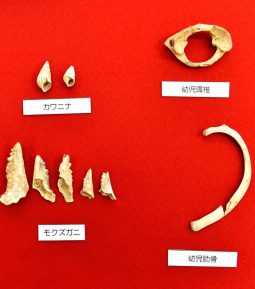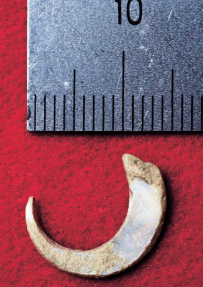World’s oldest fishing hooks from 23,000 years ago discovered in Sakitari Cave in Okinawa

A bone from an infant’s neck (top right), an infant’s rib (bottom right), freshwater snail shells (top left), and Japanese mitten crab claws (bottom left), all from about 30,000 years ago.
September 20, 2016 Ryukyu Shimpo
The world’s oldest known fishing hooks from about 23,000 years ago were discovered at Sakitari Cave in the Valley of Gangala in Nanjo City, Okinawa. An infant’s bones from about 30,000 years ago were also found at the site. These are the second oldest human bones discovered in Japan, after bones of the Yamashita Cave People from around 36,500 years ago. Furthermore, it has become clear that people of the Paleolithic Era came to catch animals from oceans and rivers for food without interruption beginning more than 30,000 years ago through the remaining 20,000 years of the Era. It used to be said that it is unclear whether or not Okinawa had a unique culture during the Paleolithic Era even though skeletons of the era had been found. However, this discovery shows that not only did present-day Okinawa have its own civilization in the Paleolithic Era, but also lends clarification to the culture of Japan during that period.

One of the world’s oldest discovered fishing hooks from about 23,000 years ago, which was unearthed in Sakitari Cave in Nanjo City, Okinawa.
The Okinawa Prefectural Museum and Art Museum has been cooperating with Nanto Bank, which manages the Valley of the Gangala, on a study there since 2009. On the 17th of this month they made the discovery public.
The fishing hooks are made out of sea snail shells and measure 1.4 centimeters across. The ends of the hooks were polished to become gradually sharp. In addition to the shell-made fishing hooks, bits of sandstone that appeared to be used to polish the hooks were found in the same geological layer. The hooks were discovered in 2012 and carbon-14 dating revealed the period during which these were used. Incomplete pieces of hooks were also unearthed.
Judging from the artifacts found, the civilization of the time made seashell spatula-like tools, shell beads, and various implements and decorations formed from sandstone.
By analyzing the large quantity of Japanese mitten crab claws and freshwater snail shells discovered, it seems that people of the time knew that the crabs mature in autumn, and chose to collect and eat them in-season.
Visiting researcher at the Research Institute of Okinawa Prefectural University Susumu Asato, who specializes in archaeology and is also the former director of the Prefectural Museum and Art Museum, said that the roots of humanity in Okinawa tracing as far back as the Yamashita Cave People have become clearer. With anticipation for the study making even more progress, he mentioned, “The relationship between the Paleolithic Era and the shell heap culture has gradually become apparent.” Results of the study were published in the US journal Proceedings of the National Academy of Sciences (PNAS), and are available online. In addition, the Prefectural Museum and Museum of Art will open a special exhibition starting on November 15 called the Palaeolithic Age of Okinawa to display relics that the excavation has unearthed.
Sakitari Cave
The cave is located in Maegawa, Tamagusu Village in Nanjo City, about two kilometers from Minatogawa Fissure where the Minatogawa People skeletons were found. Excavation by the Prefectural Museum started in 2009. Up to now, one nearly complete human skeleton from more that 9,000 years ago has been discovered there.
(English translation by T&CT and Erin Jones)
Previous Article:US base issues cast doubt on World Natural Heritage Site designation for Yambaru National Park woodlands
Next Article:Excavated fishhooks show that Paleolithic people fished, ate well
[Similar Articles]
- Japan’s oldest shell tools found in Sakitari Cave in Okinawa
- Human bones dating back 9,000 years found at Sakitari Cave
- Human bones and stone tools dating back 12000 years found in Nanjo
- Oldest Okinawan earthenware found in Sakitari Cave in Nanjo City
- 9,000-10,000-year-old bone fragments discovered in Okinawa thought to be missing link between Paleolithic and Kaizuka-era humans
 Webcam(Kokusai Street)
Webcam(Kokusai Street)


